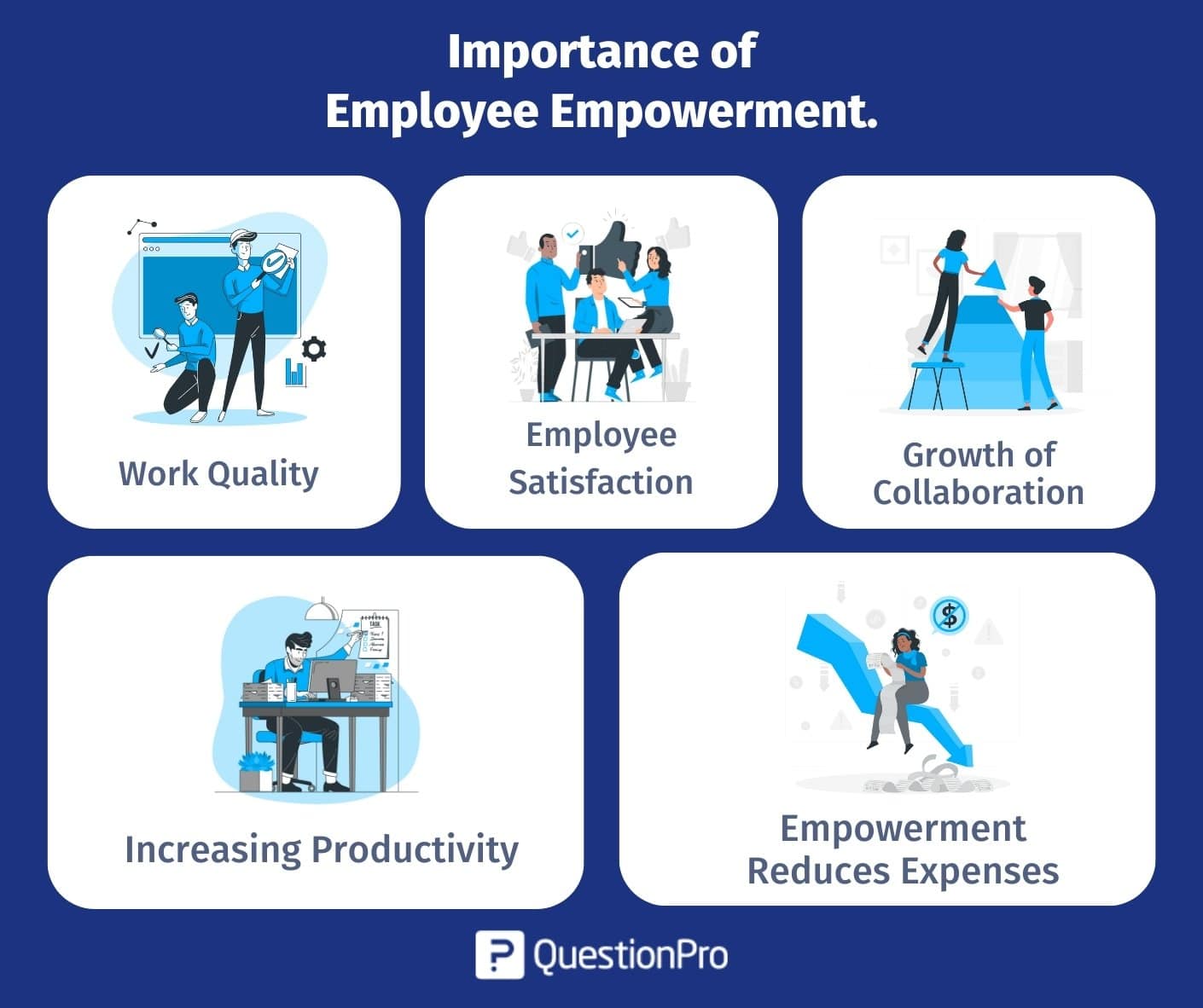Empowering employees, Employee empowerment refers to the process of giving employees the authority, autonomy, and responsibility to make decisions and take actions that contribute to the success of the organization. It involves creating a work environment where employees feel valued, trusted, and supported in their roles. Empowering employees is crucial in today’s workplace as it not only enhances individual job satisfaction and motivation but also improves overall productivity and efficiency.
Key Takeaways
- Empowering employees leads to increased job satisfaction and productivity.
- Lack of trust, communication, and support from leadership can hinder employee empowerment.
- Strategies for empowering employees include providing resources, autonomy, and recognition.
- Effective communication and leadership are crucial for successful employee empowerment.
- Creating a culture of empowerment requires ongoing training and development, as well as measuring success and addressing challenges.
Benefits of Empowering Employees
One of the key benefits of empowering employees is increased job satisfaction and motivation. When employees are given the freedom to make decisions and take ownership of their work, they feel a sense of pride and accomplishment. This leads to higher levels of job satisfaction, which in turn boosts motivation and engagement. Empowered employees are more likely to go above and beyond their assigned tasks, resulting in improved performance and productivity.
Another benefit of empowering employees is improved decision-making and problem-solving. When employees are empowered, they have the authority to make decisions that directly impact their work. This allows for faster decision-making and more effective problem-solving, as employees are able to draw on their expertise and experience. By involving employees in decision-making processes, organizations can tap into a wider range of perspectives and ideas, leading to better outcomes.
Empowering employees also contributes to higher employee retention rates. When employees feel trusted, valued, and empowered in their roles, they are more likely to stay with the organization for the long term. This reduces turnover costs and ensures continuity in the workforce. Additionally, empowered employees are more likely to recommend their organization as a great place to work, which can help attract top talent.
Factors that Hinder Employee Empowerment
While employee empowerment has numerous benefits, there are several factors that can hinder its implementation in the workplace. One such factor is a lack of trust and communication. For employees to feel empowered, there needs to be a foundation of trust between management and employees. Without trust, employees may feel hesitant to take risks or make decisions, fearing negative consequences. Similarly, effective communication is essential for empowering employees. Clear and open communication channels allow for the exchange of ideas, feedback, and information, which is crucial for empowering employees to make informed decisions.
Micromanagement and control are other factors that hinder employee empowerment. When managers excessively monitor and control every aspect of their employees’ work, it undermines their autonomy and decision-making abilities. This can lead to disengagement and demotivation among employees. To empower employees, managers need to provide guidance and support while allowing them the freedom to take ownership of their work.
Fear of failure and punishment is another factor that hinders employee empowerment. If employees are afraid of making mistakes or facing negative consequences for taking risks, they are less likely to feel empowered to make decisions. Organizations need to create a culture that encourages learning from failures and views them as opportunities for growth rather than as reasons for punishment.
Limited resources and support can also hinder employee empowerment. If employees do not have access to the necessary resources, tools, and support to carry out their responsibilities effectively, it can hinder their ability to make decisions and take ownership of their work. Organizations need to ensure that employees have the resources they need to succeed and provide ongoing support and guidance.
Strategies for Empowering Employees
| Strategy | Description | Metric |
| Training and Development | Providing employees with opportunities to learn new skills and knowledge | Number of training hours per employee |
| Flexible Work Arrangements | Allowing employees to work from home or adjust their work schedule | Percentage of employees who use flexible work arrangements |
| Recognition and Rewards | Recognizing and rewarding employees for their hard work and achievements | Employee satisfaction with recognition and rewards |
| Empowering Decision Making | Encouraging employees to make decisions and take ownership of their work | Percentage of employees who feel empowered to make decisions |
| Open Communication | Encouraging open and honest communication between employees and management | Employee satisfaction with communication |
To empower employees, organizations can implement various strategies that promote autonomy, responsibility, and decision-making. One such strategy is delegation of authority and responsibility. By delegating tasks and decision-making authority to employees, organizations empower them to take ownership of their work. This not only enhances their sense of responsibility but also allows them to develop new skills and capabilities.
Encouraging creativity and innovation is another strategy for empowering employees. Organizations can create a culture that values new ideas and encourages employees to think outside the box. By providing opportunities for employees to contribute their ideas and suggestions, organizations tap into their creativity and foster a sense of empowerment.
Providing training and development opportunities is also crucial for empowering employees. By investing in their skills and knowledge, organizations enable employees to take on new challenges and responsibilities. Training programs can equip employees with the necessary tools and knowledge to make informed decisions and contribute to the success of the organization.
Offering feedback and recognition is another strategy for empowering employees. Regular feedback allows employees to understand how their work contributes to the organization’s goals and provides them with an opportunity for growth and improvement. Recognition for their achievements and contributions reinforces their sense of empowerment and motivates them to continue performing at a high level.

Importance of Communication in Empowering Employees
Effective communication plays a vital role in empowering employees. Open and honest communication creates an environment where employees feel comfortable expressing their ideas, concerns, and suggestions. It fosters trust between management and employees, which is essential for empowering employees to make decisions and take ownership of their work.
Active listening is an important aspect of communication that empowers employees. When managers actively listen to their employees’ ideas and concerns, it shows that their opinions are valued and taken into consideration. This encourages employees to share their thoughts and contributes to a culture of empowerment.
Clear expectations and goals are also crucial for empowering employees. When employees have a clear understanding of what is expected of them and what goals they are working towards, they are better able to make decisions that align with the organization’s objectives. Clear communication of expectations also reduces ambiguity and confusion, enabling employees to take ownership of their work.
Collaborative decision-making is another important aspect of communication that empowers employees. By involving employees in decision-making processes, organizations tap into their expertise and perspectives. This not only leads to better decisions but also enhances employee engagement and commitment.
The Role of Leadership in Empowering Employees
Leadership plays a critical role in empowering employees. Effective leaders set a vision and mission for the organization that inspires and motivates employees. By clearly communicating the organization’s goals and objectives, leaders provide employees with a sense of purpose and direction, empowering them to contribute to the organization’s success.
Creating a culture of trust and respect is another important role of leadership in empowering employees. Leaders need to foster an environment where employees feel valued, trusted, and respected. This involves treating employees with fairness and transparency, listening to their concerns, and providing support and guidance when needed.
Providing support and resources is also crucial for empowering employees. Leaders need to ensure that employees have the necessary tools, resources, and support to carry out their responsibilities effectively. This includes providing training and development opportunities, as well as removing any barriers or obstacles that hinder employee empowerment.
Leading by example is another important role of leadership in empowering employees. When leaders demonstrate behaviors that align with the organization’s values and empower their own teams, it sets a positive example for others to follow. By modeling empowerment in their own actions, leaders inspire and motivate employees to take ownership of their work.
Training and Development for Empowering Employees
Training and development programs play a crucial role in empowering employees. By identifying skills and knowledge gaps, organizations can provide targeted training programs that equip employees with the necessary tools and capabilities to make informed decisions and take ownership of their work.
Providing relevant and practical training is essential for empowering employees. Training programs should be tailored to the specific needs of employees and should focus on developing skills that are directly applicable to their roles. By providing practical training that is relevant to their day-to-day work, organizations empower employees to apply their new knowledge and skills in real-world situations.
Offering mentoring and coaching is another effective way to empower employees. By pairing employees with experienced mentors or coaches, organizations provide them with guidance, support, and feedback. Mentoring and coaching relationships allow employees to learn from the experiences of others, develop new skills, and gain confidence in their abilities.
Encouraging continuous learning and improvement is also crucial for empowering employees. Organizations should create a culture that values learning and provides opportunities for employees to expand their knowledge and skills. This can include offering access to online courses, providing time for self-directed learning, or supporting employees in pursuing further education or certifications.
Creating a Culture of Empowerment in the Workplace
Creating a culture of empowerment is essential for fostering employee empowerment in the workplace. Organizations need to foster a positive and inclusive work environment where employees feel valued, respected, and empowered to contribute their ideas and perspectives.
Encouraging teamwork and collaboration is an important aspect of creating a culture of empowerment. By promoting a collaborative work environment, organizations tap into the collective knowledge and expertise of their employees. This not only leads to better decision-making but also enhances employee engagement and satisfaction.
Recognizing and rewarding success is another important aspect of creating a culture of empowerment. When employees’ achievements and contributions are recognized and rewarded, it reinforces their sense of empowerment and motivates them to continue performing at a high level. Recognition can take various forms, such as verbal praise, monetary rewards, or opportunities for career advancement.
Embracing diversity and inclusion is also crucial for creating a culture of empowerment. Organizations need to value and respect the diverse backgrounds, perspectives, and experiences of their employees. By embracing diversity and inclusion, organizations tap into a wider range of ideas and perspectives, which enhances decision-making and problem-solving.
Measuring the Success of Employee Empowerment
Measuring the success of employee empowerment is essential for organizations to assess the effectiveness of their strategies and make any necessary adjustments. There are several ways organizations can measure the success of employee empowerment.
Setting measurable goals and objectives is an important first step in measuring the success of employee empowerment. By setting clear goals that are aligned with the organization’s objectives, organizations can track progress and measure the impact of their empowerment initiatives.
Collecting and analyzing data is another important aspect of measuring the success of employee empowerment. Organizations can collect data on various metrics, such as employee satisfaction, productivity, and retention rates. By analyzing this data, organizations can identify trends and patterns that indicate the effectiveness of their empowerment strategies.
Soliciting feedback from employees is also crucial for measuring the success of employee empowerment. Organizations can conduct surveys, hold focus groups, or have one-on-one conversations with employees to gather their feedback and insights. This feedback provides valuable information on how employees perceive the effectiveness of empowerment initiatives and can help identify areas for improvement.
Adjusting strategies and approaches as needed is another important aspect of measuring the success of employee empowerment. Based on the data and feedback collected, organizations can make any necessary adjustments to their strategies and approaches to ensure continued success in empowering employees.
Challenges in Implementing Employee Empowerment
Implementing employee empowerment can be challenging for organizations. There are several common challenges that organizations may face when trying to empower their employees.
Resistance to change is a common challenge in implementing employee empowerment. Employees may be resistant to change due to fear of the unknown or concerns about their ability to adapt to new ways of working. Organizations need to address these concerns by providing clear communication, training, and support throughout the implementation process.
Lack of resources and support can also pose a challenge in implementing employee empowerment. If employees do not have access to the necessary resources, tools, and support to carry out their responsibilities effectively, it can hinder their ability to make decisions and take ownership of their work. Organizations need to ensure that employees have the resources they need to succeed and provide ongoing support and guidance.
Limited buy-in from leadership is another challenge in implementing employee empowerment. If leaders do not fully support and embrace the concept of employee empowerment, it can hinder its implementation throughout the organization. Organizations need to ensure that leaders understand the benefits of employee empowerment and are committed to its implementation.
Inconsistent implementation is another challenge in implementing employee empowerment. If employee empowerment initiatives are not consistently implemented across the organization, it can lead to confusion and frustration among employees. Organizations need to ensure that empowerment strategies and approaches are consistently applied throughout the organization to maximize their effectiveness.
Conclusion and Call to Action for Empowering Employees
In conclusion, empowering employees is crucial in today’s workplace. It not only enhances individual job satisfaction and motivation but also improves overall productivity and efficiency. By implementing strategies such as delegation of authority, encouraging creativity, providing training and development opportunities, and fostering open communication, organizations can empower their employees to make informed decisions and take ownership of their work.
Creating a culture of empowerment requires leadership commitment, support, and the establishment of clear expectations and goals. By embracing diversity and inclusion, recognizing and rewarding success, and measuring the impact of empowerment initiatives, organizations can create a work environment where employees feel valued, trusted, and empowered.
It is important for organizations to take action to empower their employees. By prioritizing employee empowerment in the workplace, organizations can reap the benefits of increased job satisfaction, improved productivity, better decision-making, and higher employee retention rates. Empowered employees are more likely to be engaged, motivated, and committed to the success of the organization. Therefore, organizations should make employee empowerment a priority in their strategic plans and invest in the necessary resources and support to make it a reality.

FAQs
What is employee empowerment?
Employee empowerment is the process of giving employees the authority, resources, and tools they need to make decisions and take actions that will improve their work and the organization as a whole.
Why is employee empowerment important?
Employee empowerment is important because it can lead to increased job satisfaction, higher productivity, and better customer service. When employees feel empowered, they are more engaged and motivated to do their best work.
What are some ways to empower employees?
Some ways to empower employees include giving them more autonomy and decision-making power, providing them with training and development opportunities, recognizing and rewarding their contributions, and creating a culture of trust and collaboration.
What are the benefits of empowering employees?
The benefits of empowering employees include increased job satisfaction, higher productivity, better customer service, improved innovation and creativity, and a stronger sense of ownership and commitment to the organization.
How can managers support employee empowerment?
Managers can support employee empowerment by providing clear expectations and goals, giving employees the resources and tools they need to succeed, providing regular feedback and coaching, recognizing and rewarding employee contributions, and creating a culture of trust and collaboration.
To Read More About Empowering employees
To Read About Black motivational speakers










